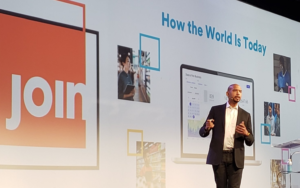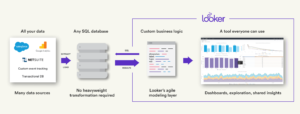
Beyond BI: Looker Seeks Bigger Role for Data

Looker CPO Nick Caldwell at JOIN 2019 November 6, 2019
Looker is best known as a business intelligence platform, which it definitely is. But with today’s release of Looker 7, the company is making a strong case that it’s much more than that. In fact, here at its user conference, company representatives say Looker should be considered a development platform, first and foremost.
Looker has always been a wary participant in the BI market. Yes, Looker lets you build BI reports and dashboards. But thanks to several aspects of its platform, starting with its modeling language, called LookML, Looker’s capabilities go far beyond that.
“Looker is so different than everything else on the market,” Looker founder and CTO Lloyd Tabb said during a discussion on stage at JOIN 2019, the company’s annual user conference in San Francisco. “We get lumped in BI a lot. But we’re very hard to describe, because we fit in the middle of a lot of things.”
When a Looker user does the work to define a new source of data using LookML, it not only gives the user the confidence to establish a single source of truth for that data, which impacts downstream BI assets like dashboards and reports. It also opens up that data to be applied in a number of new ways via the Looker platform. When paired with a data warehouse (often one running in the cloud, often named BigQuery), Looker can help power ETL and ELT workloads.
“Looker…sits on the data and gives you real-time access,” Tabb said. “We connect to all these different sources, so actually being able to operate in real time and react in real time is what makes people successful with data. And our architecture supports that. All the things you can build with it is really fascinating.”
Data Experiences
With today’s unveiling of Looker 7, the company is bolstering its case that Looker’s number one job is being a development environment for building data-centric apps. To that end, the company is launching a development framework that allows customers to create “data experiences” atop Looker using a variety of pre-built components.
Examples of these new data experiences could be a new application that integrates Looker-governed data, or injecting the data into a business workflow or pipeline, said Pedro Arellano, product marketing manager for Looker.
“The solution to every problem is not dashboards,” Arellano tells Datanami. “There are solutions that are out there that are really interesting and innovative that still require data, but do not involve putting numbers on a chart.”
One large retailer is running analytics atop security event data that’s streamed into a cloud data lake. That Looker application replaced Splunk and allowed them to save millions of dollars, Arellano said. A trucking company is using Looker to gather and analyze data about drivers to determine whether it will have enough drivers the following day. Ad bidding firms are using Looker to adjust their bids in real time.
Looker can do a lot more than most people are aware — much more than you’re run of the mill BI tool, according to Nick Caldwell, Looker’s chief product officer.
“If you’re a desktop BI tool, you’re sitting in some tool manually joining tables together, and every time the underlying data set changes it just breaks all of your workloads,” Caldwell said. “Or if you’re a data engineer, you’re writing Python scripts to do ETL jobs, which are also usually brittle.”
Manually joining tables and maintaining ETL scripts worked in the old days because the scale was smaller, Caldwell said. But that approach does not scale in today’s data environment, where the average company has 1,100 SaaS apps and data is spread everywhere.
“With Looker, rather than trying to continue to maintain all these crazy Python scripts and workbooks, you do your edits inside LookML, so there’s one definition of all the data schema for the whole company, and there’s a whole flotilla of tools that do nothing but make sure that definition is valid and that multiple people can work on it,” Caldwell said.
Other BI tools come at it from a top-down point of view, and when a user tries to reach down into the data to effect operations, they run into walls, he said. “Whereas Looker comes at it the other way around,” Caldwell continued. “We’ve got to know where all your important data is. We’re going to make it easy to access and trustworthy, step one, and then you do all this other cool stuff — your analytics get better and your workflow improves.”
Focus on App Dev
Looker 7 brings a number of new capabilities for developer, including new SDKs for Python, Kotlin, and Swift to complement an existing SDK for JavaScript. The company is also launching a versatile Codegen SDK that allows the Looker community to create additional SDK for languages that aren’t currently supported, like Java and C#. These SDKs complement an existing iFrames implementation, as well as the open API.
A new embedded SDK that complements existing white label and OEM options will help Looker customers embed analytics directly into their existing applications. According to Arellano, the SDK takes care of all the hooks. “So all the wiring between the parent application and the looker content is now done by the SDK,” Arellano said. “It makes it a lot faster and a lot easier to do these kinds of things.”
Every platform needs a community to sustain organic growth, and it appears that Looker’s community is starting to blossom. Looker developers who are concerned about the accuracy of data models in LookML may be interested in Spectacles, a new continuous integration (CI) tool for Looker that is currently in alpha and available for download at its GitHub repository.
That’s the type of product that you can expect to find on Looker Marketplace, another new feature of Looker 7 unveiled today. Nick Fogler, CEO and founder of 4Mile Analytics, is also excited about the new marketplace. “The launch of Marketplace is also a really important business opportunity for partners like us because we get to distribute our solutions to all of Looker’s customers,” Fogler said in a press release.
The Looker community is getting the message about developing apps with the platform. According to Looker CEO Frank Bien, half of all Looker users are creating apps with the platform. And while developers are core focus, the company didn’t leave BI out of the equation with Looker 7.
Users will see an improved UX in Looker 7, including custom range finders and “cross filter” capabilities in the Looker Explorer GUI. There’s also a new integration with Slack that allows Slack users to call up Looker data without leaving the conversation. New connectors have also been released to pull data from Dropbox, Box, Google Drive, Auger.ai, mParticle, Matik and Spiff.com.
Data in the Cloud
Looker, which in the process of being acquired by Google for $2.6 billion, also unveiled a new hosted data warehousing service with the launch of Looker 7. Customers who opt for this service will be given an instance of BigQuery for housing their data and an OEM copy of FiveTran for moving data into the warehouse — and of course Looker sitting on top. The company will roll out support for other cloud data warehouses in the future.
Looker is often deployed on the cloud, and with Looker 7, those deployments are simplified thanks to Looker’s support for the Kubernetes workload orchestration technology. Support for Kubernetes streamlines multi-cloud environments, which Looker supports. However, Kubernetes is not yet supported for on-prem or hybrid deployments.
BI remains the most popular type of Looker app, and thousands of users get reports and dashboards out of their Looker environments. But according to the CEO, Looker is on the cusp of opening new opportunities for clients and their data.
“Business does not want the same thing that we were doing yesterday. They want more. They want to use data more and more to solve business problems in their organizations,” Bien said. “Data isn’t just informing what we did. It’s becoming how we work. I think that really allows us to move into using data to do our job, versus looking in the rear view mirror.”
Related Items:
Hadoop Struggles and BI Deals: What’s Going On?
Looker Spies Next Step In Data-Based Evolution
Looker’s Audacious Moonshot to Outgrow Oracle
































